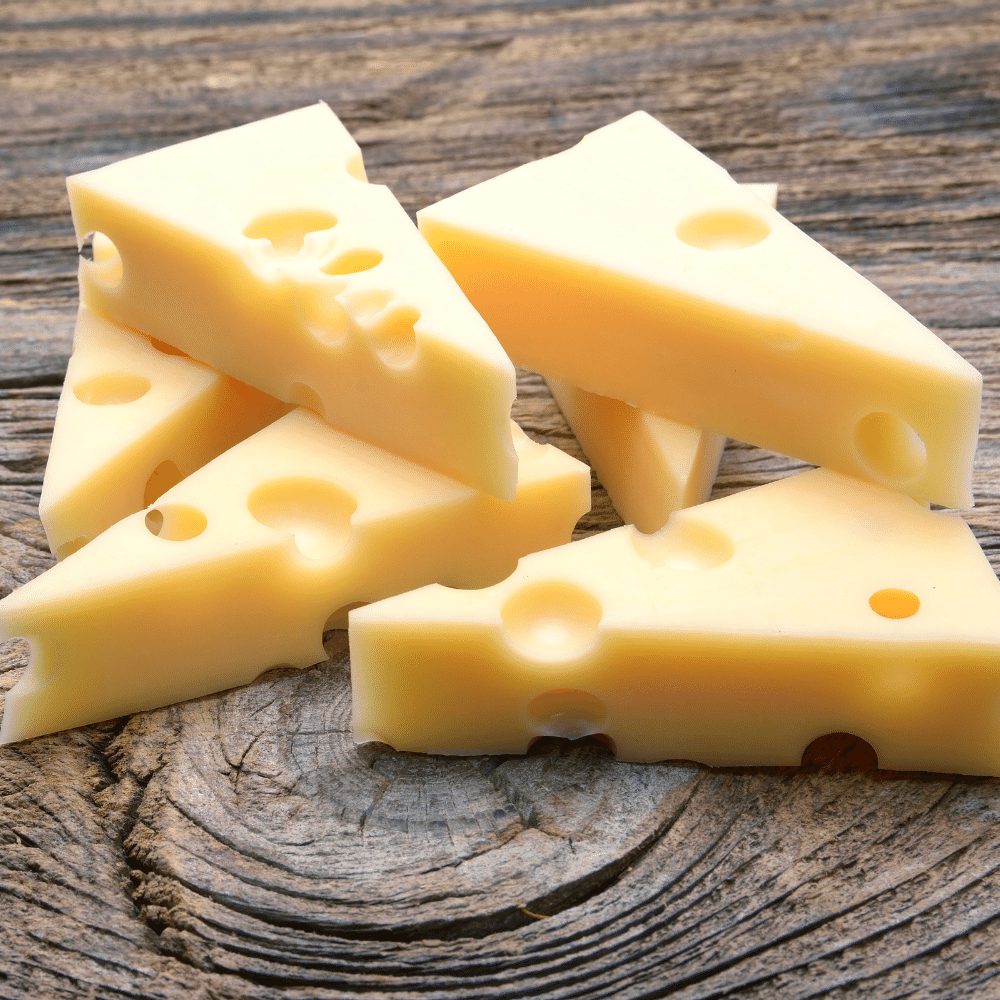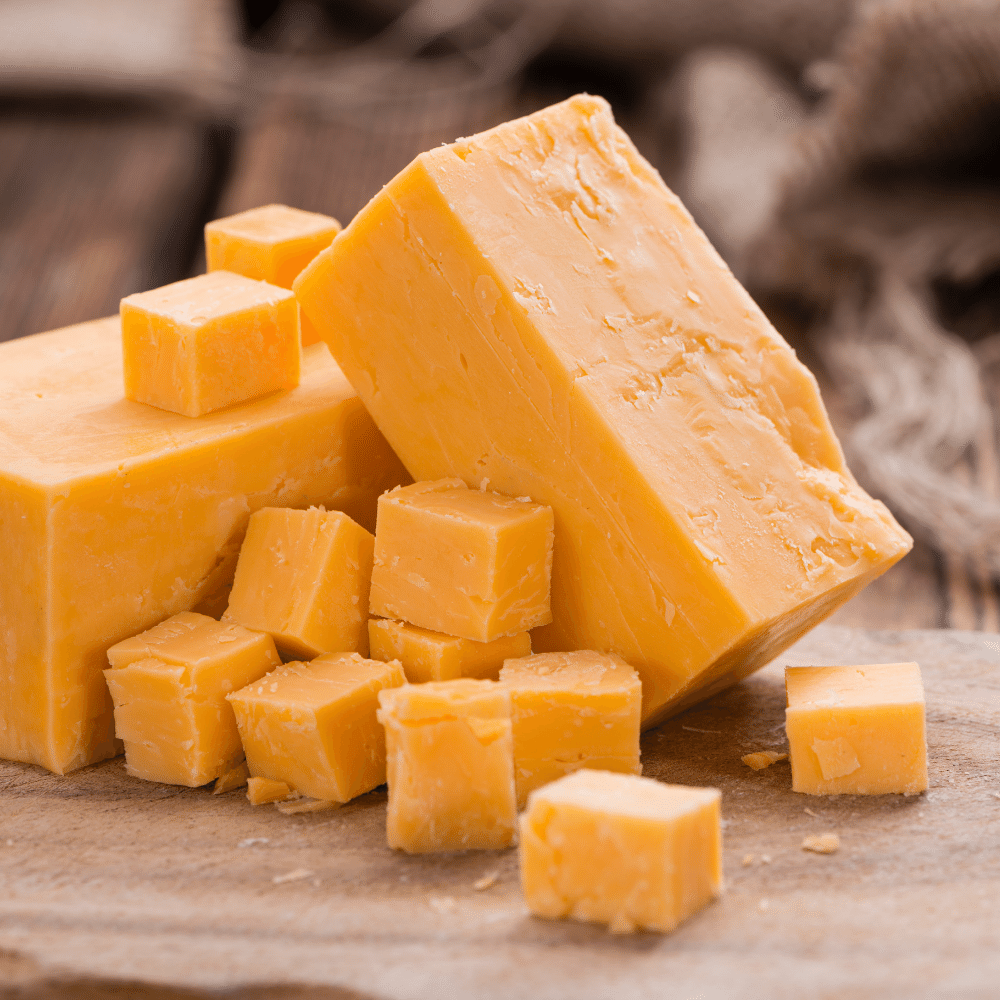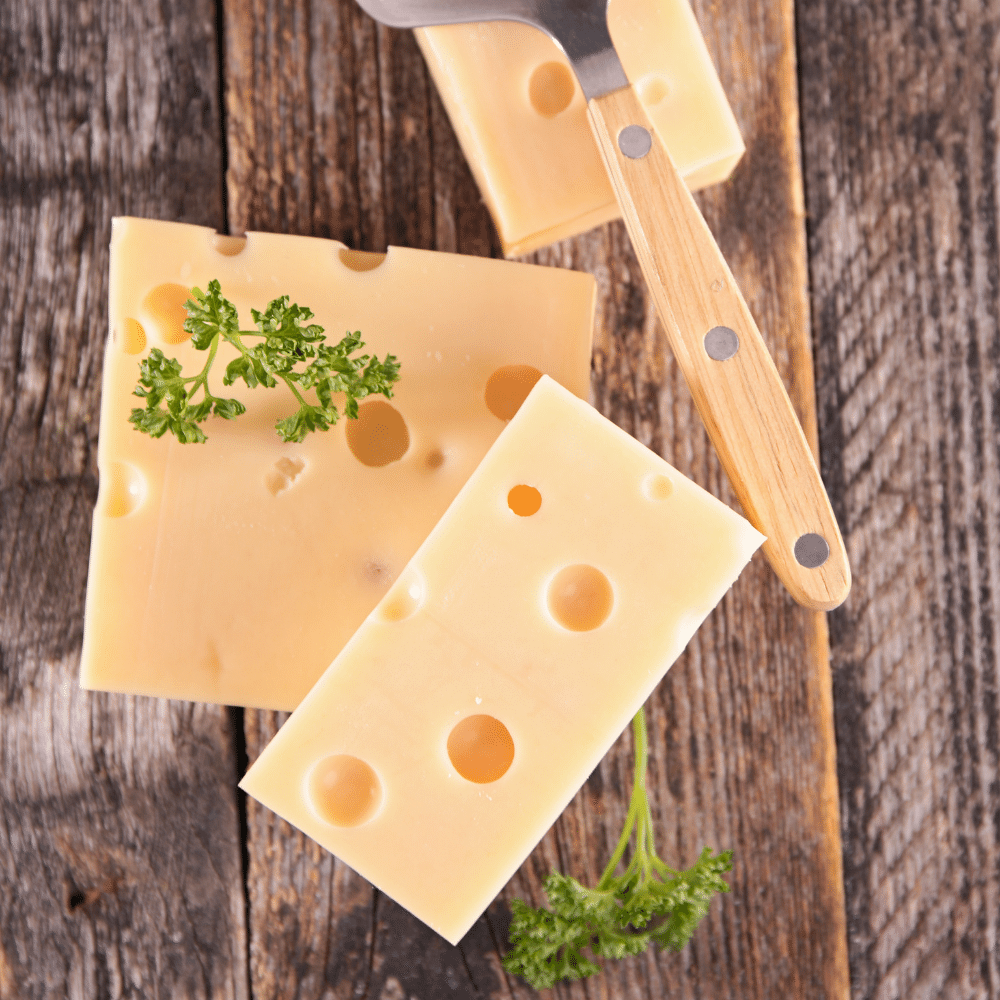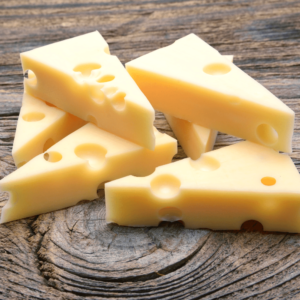If you’re a fan of cheese, then you probably know about Emmental.
This Swiss classic has been around for centuries and is one of the most popular cheeses in the world.
But what if you can’t find Emmental or don’t want to use it?
Or maybe your diet restricts it for some reason?
No worries!
There are plenty of delicious substitutes for Emmental that will make your dishes even tastier.
From Gouda to Gruyere, I have compiled a list of 12 fantastic alternatives so that you can enjoy all sorts of cheesy goodness without compromising on flavor.
What is Emmental Cheese?

Emmental cheese is a type of Swiss cheese that originated in the Emme Valley in Switzerland.
It is also known as Emmentaler, or sometimes just “Swiss” cheese.
The name comes from the German word for valley, “Emme.”
Emmental has a mild nutty flavor and a firm texture with small holes throughout.
It is made from cow’s milk and aged for at least four months to develop its characteristic flavor and texture.
The aging process gives it an orange-brown rind and a pale yellow interior with large eyes (holes).
The traditional method of making Emmental involves heating the curdled milk until it forms into one mass, then cutting it into cubes before pressing them together to form wheels of cheese.
After this, they are soaked in brine for several days before being placed on wooden shelves where they are left to age for up to 12 months or more.
During this time, bacteria break down proteins in the cheese which produces carbon dioxide gas bubbles that create the distinctive holes throughout the wheel of cheese.
The 12 Best Substitutes For Emmental Cheese
If you can’t find Emmental, don’t worry – there are several other options.
Here we look at twelve alternatives that will offer a similar taste and texture:
1 – Comte Cheese

Comté cheese is a type of French cheese made from unpasteurized cow’s milk.
It has a hard, yellow-brown rind and a pale yellow interior with small holes.
The flavor is nutty and slightly sweet, with notes of hazelnut and butter.
Comté is often used in fondue or melted over dishes like potatoes or vegetables.
Comté cheese can be enjoyed on its own as part of an appetizer platter, but it also pairs well with fruits such as apples or pears, nuts such as walnuts or almonds, and cured meats like prosciutto or salami.
Its nutty flavor makes it ideal for adding to salads and sandwiches too!
2 – Fontina Cheese

Fontina cheese is a semi-soft Italian cheese made from cow’s milk.
It has a mild, nutty flavor and creamy texture that makes it perfect for melting.
Fontina is often used in fondue, grilled sandwiches, and pasta dishes.
Fontina has a slightly sweet taste with hints of butter and hazelnut. Its texture can range from soft to firm depending on how long it has been aged.
The rind is edible but not particularly flavorful so it’s best to remove before eating or cooking with the cheese.
Pro Tip: Fontina pairs well with cured meats like prosciutto or salami as well as fresh fruits like pears or apples. Try adding some fontina to your next charcuterie board for an extra special touch!
3 – Raclette

Raclette is a semi-hard cheese made from cow’s milk.
It has a mild, nutty flavor and is often used as an ingredient in fondue or melted over potatoes.
Raclette can also be eaten on its own with bread or crackers, or served as part of a cheese platter.
Raclette has a creamy texture and melts easily when heated.
Its flavor is slightly sweet and nutty, making it the perfect accompaniment to meats and vegetables.
The cheese pairs well with white wines such as Riesling or Sauvignon Blanc, as well as fruity reds like Pinot Noir.
Pro Tip: If you’re looking for an easy way to enjoy raclette at home, try using your oven broiler! Place slices of the cheese on top of boiled potatoes and heat until melted – delicious!
4 – Cheddar

Cheddar is a hard, yellow cheese made from cow’s milk.
It has a sharp, tangy flavor and is often used in sandwiches, salads, and sauces.
Cheddar is one of the most popular cheeses in the world and can be found in many different varieties.
Cheddar has a milder flavor than Emmental but still packs plenty of punch.
It’s great for melting on top of burgers or adding to macaroni and cheese dishes.
The texture of cheddar also makes it ideal for grating over pasta or using as an ingredient in quiches and omelets.
5 – Manchego Cheese

Manchego cheese is a Spanish cheese made from sheep’s milk.
It has a firm texture and a slightly nutty flavor with hints of butter, making it an ideal choice for snacking or cooking.
Manchego is one of the most popular cheeses in Spain and can be found in many supermarkets around the world.
Manchego has a distinctive flavor that sets it apart from other cheeses.
Its taste is described as being slightly sweet, nutty, and buttery with notes of caramelized onions and toasted nuts.
The texture ranges from semi-soft to hard depending on its age; younger Manchegos are softer while aged ones are harder and more crumbly.
6 – Gruyere

Gruyere is a hard, yellow cheese made from cow’s milk.
It has a creamy texture and nutty flavor that makes it perfect for melting in dishes like fondue or macaroni and cheese.
Gruyere is also great for grating over salads or pasta dishes.
Gruyere is similar to Emmental but with a slightly sharper taste.
It’s also firmer than Emmental, which makes it better suited for grating and slicing.
The flavor of Gruyere can range from mild to sharp depending on how long it has been aged.
Pro Tip: If you’re looking for an alternative to Emmental, try using Gruyere in your recipes! Its nutty flavor will add depth and complexity to any dish you make!
7 – Gouda

Gouda is a semi-hard cheese made from cow’s milk.
It is one of the most popular cheeses in the world and has a mild, nutty flavor with a slightly sweet aftertaste.
Gouda can be eaten on its own or used as an ingredient in dishes such as macaroni and cheese, quiches, sandwiches, and more.
Gouda is similar to Emmental but has a much milder flavor.
The texture of Gouda is also softer than that of Emmental. Gouda can be enjoyed melted on toast or added to salads for extra flavor and creaminess.
It also pairs well with fruits like apples and pears for a delicious snack!
8 – Jarlsberg Cheese

Jarlsberg cheese is a semi-hard cow’s milk cheese originating from Norway.
It has a mild, nutty flavor and a smooth texture with large holes throughout.
The cheese is made from pasteurized cow’s milk and contains no preservatives or additives.
Jarlsberg cheese can be used in many dishes such as sandwiches, salads, omelets, quiches, soups, sauces and more.
It melts easily making it perfect for grilled cheeses or melted over vegetables.
Its mild flavor makes it an excellent choice for those who don’t like strong-flavored cheeses.
Pro Tip: Jarlsberg cheese pairs well with white wines such as Chardonnay or Sauvignon Blanc and also goes great with fruit preserves or honey!
9 – Parmesan

Parmesan cheese is a hard, granular cheese originating in Italy.
It has a sharp, salty flavor and is often used as an ingredient in Italian dishes such as pasta and pizza.
Parmesan can also be grated over salads or soups for added flavor.
Parmesan has a nutty, slightly sweet taste that is similar to Emmental but with more intensity.
The texture of Parmesan is much harder than Emmental and it crumbles easily when grated or shaved.
Pro Tip: To get the most out of your Parmesan cheese, try using it freshly grated instead of pre-grated from the store! Freshly grated Parmesan will have more flavor and aroma than pre-grated varieties.
10 – Havarti

Havarti is a semi-soft cow’s milk cheese with a mild, buttery flavor and small irregular holes.
It has a creamy texture that melts in your mouth and can be used for sandwiches, salads, or melted over vegetables.
Havarti is similar to Emmental but it has a slightly sweeter taste and less of the nutty flavor.
The texture is also creamier than Emmental which makes it great for melting on top of dishes like macaroni and cheese or grilled cheese sandwiches.
Pro Tip: Havarti pairs well with fruits like apples, pears, grapes, and berries as well as nuts such as walnuts or almonds. Try adding some Havarti to your next charcuterie board for an extra special touch!
11 – Provolone

Provolone is an Italian cheese made from cow’s milk. It has a mild, slightly sweet flavor and a smooth texture that melts easily.
Provolone can be used in many dishes, from sandwiches to pizzas to pasta sauces.
Provolone is often compared to Emmental cheese due to its similar nutty flavor and creamy texture.
However, Provolone has a sharper taste than Emmental and tends to be less pungent.
It also has a higher melting point than Emmental, making it ideal for grilling or baking dishes where you want the cheese to stay intact rather than melt away completely.
12 – Brie Cheese

Brie is a soft, creamy cheese made from cow’s milk.
It has a mild flavor and a slightly salty taste. Brie is often served as an appetizer or snack, but it can also be used in cooking to add richness and depth of flavor to dishes.
Brie is similar to Emmental in that it has a mild, buttery flavor with nutty undertones.
However, Brie tends to have more of an earthy flavor than Emmental due to its higher fat content.
Additionally, Brie has a softer texture than Emmental which makes it ideal for spreading on crackers or breads.
Pro Tip: To get the most out of your brie cheese experience, serve it at room temperature so that you can enjoy its full range of flavors!
FAQ
What Cheese Tastes Like Emmental?
The best cheese to substitute for true Emmental cheese is Gruyere cheese. Both Emmental and Gruyere cheese are of Swiss heritage and are made from cow’s milk, which gives them a similar nutty and buttery flavor.
However, Gruyere cheese is slightly less sharp and has a slightly sweeter taste than its Emmental counterpart. This makes it an ideal substitute for Emmental cheese, as it melts very well and is the primary cheese used in fondue.
Whether you are baking, grilling, or making fondue, Gruyere cheese is the perfect choice for a cheese that tastes like Emmental.
Can I Use Swiss Cheese Instead of Emmental?
Yes, you can use Swiss cheese instead of Emmental, however you should be aware that it may not taste quite the same. The best substitutes for Emmental are Gruyere, Jarlsberg, and French Comte.
Gruyere has a more pronounced nutty flavor than Emmental, while Jarlsberg is a good Swiss cheese alternative. French Comte tastes very similar to Gruyere, and is a great option if you can’t find Emmental.
Keep in mind that the texture and flavor of these cheeses may differ slightly from Emmental, so you may need to adjust the dish accordingly.
Is Emmental Similar to Cheddar?
No, Emmental and Cheddar cheeses are not similar. Although both are popular Swiss cheeses, Emmental is mild, sweet, and nutty with no acidity or salt. In comparison, Cheddar is tangy, salty, and earthy, with a strong flavor that increases with age.
Even Mild Cheddar, which has a softer and smoother texture and is less sharp than aged Cheddar, is still too tangy and salty to be compared to the milder Emmental.
Does Emmental Store Well?
Yes, Emmental cheese does store well. When left unopened, it can last up to three months in the refrigerator or even longer if kept in a cool cellar. However, once opened, it is best to use it within four to eight weeks to ensure optimal flavor and texture quality.
To prolong its shelf life, store it in a tightly sealed container or wrap it tightly in plastic wrap or wax paper. Additionally, make sure to store it away from other strong-smelling foods as it can absorb odors easily.
Conclusion
In conclusion, Emmental cheese is a versatile and flavorful cheese that can be used in a variety of dishes.
However, if you don’t have Emmental cheese on hand, there are a variety of other cheeses that can be used as a good substitute.
Some of the best substitutes for Emmental cheese are Comte cheese, Fontina cheese, Raclette, Cheddar, Manchego cheese, Gruyere, Gouda, Jarlsberg cheese, Parmesan, Havarti, Provolone, and Brie cheese.
Each of these cheeses has its own unique flavor and texture, so you can experiment with different combinations to find the perfect cheese for your dish.
Using the right cheese can make all the difference when it comes to adding flavor to your dish, so be sure to experiment with different types of cheese to find the perfect flavor combination.

The 12 Best Substitutes For Emmental Cheese
Ingredients
- Comte Cheese
- Fontina Cheese
- Raclette
- Cheddar
- Manchego Cheese
- Gruyere
- Gouda
- Jarlsberg Cheese
- Parmesan
- Havarti
- Provolone
- Brie Cheese
Instructions
- Pick your favorite substitute from the list above.
- Follow cooking directions for your selected substitute with the proper ratio of ingredients.
Hi, I'm Benjamin. I love cooking, long walks, and my girlfriend! Here you’ll find simple and delicious recipes that you can make in 30 minutes or less.

